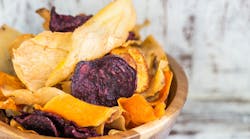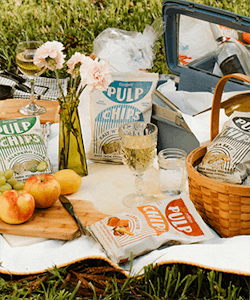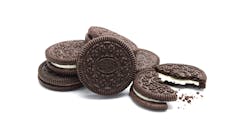When Kaitlin Mogentale was creating Pulp Pantry, which makes snacks from vegetable byproducts, she was motivated by more than just profiting from food waste. What drove the idea, she says, was the hope of creating a product that tasted good, was naturally healthy and helped the environment.
“Exploring the relationship between food, health and environment became one of my greatest passions,” Mogentale says.
Pulp Pantry, which launched in 2015, now offers four varieties of Pulp Chips. About half of the ingredients are “upcycled” vegetable byproducts like fiber from kale and celery. The chips are gluten-free, vegan and contain 5g of fiber and 150 calories per serving.
Kaitlin Mogentale created Pulp Pantry, which makes snacks from vegetable byproducts.
Pulp Chips illuminate two key trends in snack foods: They are more nutritious than many typical snacks and they offer consumers a feel-good story of salvaging food that otherwise would to go waste.
“There’s nothing better than keeping nutritious food out of landfills, and into people’s mouths,” Mogentale says.
Driven by COVID
The COVID crisis has impacted snack food trends in two ways – more time at home means more snacking, and a worldwide pandemic means health is top of mind.
“Interest in snacking has increased due to the pandemic, as has public interest in health,” says Bill Glaser, CEO of Outstanding Foods, a manufacturer of gluten-free, vegan and kosher snack chips. “Consumers want their snack foods to evolve with their diet.
"We were able to raise $10 million this year due to the interest in plant-based snacking, and we don’t foresee this trend changing anytime soon," he continues. "Consumers are choosing healthier options at the bodega or the 7-Eleven, and the snack food industry has noticed.”
Like Pulp Chips, the products that come from Outstanding Foods are designed to satisfy consumers’ desire for something crunchy while also being nutritious. Outstanding Foods products – Pig Out Pigless Pork Rinds, Take Out Meal-In-A-Bag Puffs, and Pig Out Pigless Bacon – aim to please people on a plant-based diet who occasionally crave the taste of meat.
“Our new product ideas always come from analyzing consumer behavior and tracking new problem areas in plant-based snacking that we can help alleviate,” Glaser says. “That’s why we chose to focus on pork substitutes since we noticed there was a gap in plant-based offerings for pork-inspired products.”
All of the company’s products are made with vegetable ingredients. The Pigless Pork Rinds, for example, are made from rice, pea protein and sunflower oil.
Not all better-for-you snacks are that complex. Some are normal foods repackaged as snacks.
“When it comes to better-for-you, there are a lot of perishable items, like snap peas and dip,” notes Jessica Cristadoro, chief science officer of Food Business Consulting LLC. “There are also a lot of meat and cheese combinations. And Sargento and others are combining cheese, nuts and fruit to get into the everyday snacking category.”
The fact that COVID is keeping people at home means more to the snack food industry than just greater consumption. It also means people are bored and consequently open to trying snack foods they may have ignored in the hectic days before COVID. That’s good news for smaller snack-makers.
“Consumers are into trying new things because they’re at home so much and can order products on the internet,” notes Karina Martinez, owner of Avana Creative, a public relations and branding agency that works with food and beverage manufacturers. “That has given emerging brands a lower barrier to entry. They can open a website and start selling online quickly and have access to more consumers.”
Will the effects of COVID last when the crisis subsides? That’s a mystery.
“It will be interesting to see what happens when things go back to normal,” Cristadoro says. “Will we see these things that were innovative disappear? I think that’s kind of a risk for food manufacturers – is it sustainable?”
Upcycled on the upswing
The concept of using byproduct from other food manufacturing processes to create snacks is a trend several years in the making. Companies like Pulp Pantry, Coffee Cherry Co. and Boomerang Food are finding success with the concept, and there’s even a trade organization – Upcycled Food Association – that promotes the idea.
“People are saying, ‘How do we mitigate waste and create something delicious?’” Martinez says. “People are finding ways to recreate a byproduct into something.”
Upcycling food can have a measurable impact on waste reduction, Mogentale says. Her company’s analysis shows that their process saves 1kg of CO2 for every pound of food upcycled – based on the CO2 used in the production and transportation of their food resources – and nearly 38 gallons of water.
Pulp Pantry’s main supplier is Suja Juice, which makes cold-pressed juice beverages from celery, cucumbers, kale and other fruits and vegetables. Pulp Pantry takes the fiber-rich pulp left over from the Suja process and mixes it with other plant-based ingredients such as tapioca, chia seeds and cassava.
“We have worked through so many kinks associated with maintaining quality and freshness of byproduct ingredients,” Mogentale explains. “It's not an easy ingredient to handle. For the most part, we're sourcing byproduct fresh, and incorporating fresh ingredients directly into our own manufacturing process as an input.
"We're in a place now where we've mastered what works (and what doesn't) with handling fresh and highly perishable ingredients, from collection to storage to transportation to our facility for processing.” The upcycled pulp from Suja Juice helps create a nutrient-packed chip, Mogentale says.
“We focus most on fiber as the macronutrient of the most value in the pulp, although there are studies that show other vitamins and minerals may be preserved in the pulp, depending on the type of produce used,” she says.
Another food manufacturer making snacks from upcycled byproduct is Brewer’s Crackers, which make crackers from the spent grains left over from beer brewing.
“When making beer, brewers steep super high-quality grains, like barley, in water,” explains Justin Luedecker, a spokesperson for Brewer’s Crackers. “They then strain this mixture, keeping the liquid to make beer and discard the ‘spent’ grains.
"Turns out, these grains are still incredibly flavorful and the steeping process actually unlocks valuable nutrients," he continues. "Brewer’s Crackers recycles these grains into their crackers and combines them with 100 percent whole wheat flour.”
The company launched its products in 2019, and currently offers two varieties of crackers – Honey Graham and Sesame Sea Salt – and two varieties of flatbread – Sea Salt and Everything.
Manufacturing challenges
The trend toward creating healthier snacks has not come without costs. Challenges range from finding ingredients to maintaining an allergen-free factory.
For example, creating snacks that are healthier than other snacks often requires replacing key ingredients, such as artificial flavor enhancers, that are not considered healthy. Or it means trying to incorporate more nutritious ingredients, as Pulp Products does with pulp byproducts. Either way, those modifications often lead to manufacturing challenges.
“New healthy ingredients can have different taste, texture, and mouthfeel that has to be incorporated into a product in a way that does not sacrifice taste,” explains Robert Schumann, director of marketing for KPM Analytics. “New ingredients may also affect how the product is manufactured, which requires new formulations and engineering to mass produce. A good example is the gluten-free trend, where non-wheat replacement ingredients present a complex challenge to new product formulation and manufacture.”
Technology can help alleviate that situation, Schumann says. “In the past five years, KPM Analytics has seen a significant increase in the use of our Mixolab and Alveolab products from Chopin Technologies to help develop and monitor gluten-free products that taste good and have the right texture and mouthfeel.”
Steffen Weck, CEO of Food Business Consulting LLC, echoes Schumann’s point about the taste of healthy snacks. Many healthier ingredients – such pea protein -- simply don’t taste good, he says. That means manufacturers who want to use those ingredients need to cover up the flavor with another ingredient or use a masking agent to change the flavor.
Another challenge in the healthy snack category is the manufacturing challenge of combining ingredients that previously haven’t been combined. “That creates a whole slew of processing challenges,” Weck says.
Novel ingredients sometimes also pose supply problems. For example, Weck says his company helped a client create a pizza crust using cauliflower, but the project was never launched because they couldn’t secure enough cauliflower flour.
“The agricultural supply chain has to catch up on these things,” Weck says. “You have to secure the supply chain before you launch a new product.”
Allergen-free snacks represent another challenge altogether. Wade Crouch, head of marketing for Riverside Natural Foods, which manufactures MadeGood allergen-free, organic crackers, granola bars and cookies, explains that the company had to develop rigorous protocols to ensure that no allergens enter its 400,000-sq.-ft. factory and distribution space.
“Our entire facility is allergen-free, meaning so are our office and lunchroom areas,” Crouch says. “We provide training, signage and visitor screening to reinforce our practices. Visiting technicians are instructed to even use our tools rather than bring in their own that may have been used at other food manufacturing facilities with allergens.”
Challenges notwithstanding, healthier snacks are taking up more space on store shelves than ever before. Whether the snacks are made from upcycled vegetables or staples like cauliflower that are suddenly in great demand, the trend for healthier snacking is here to stay.


